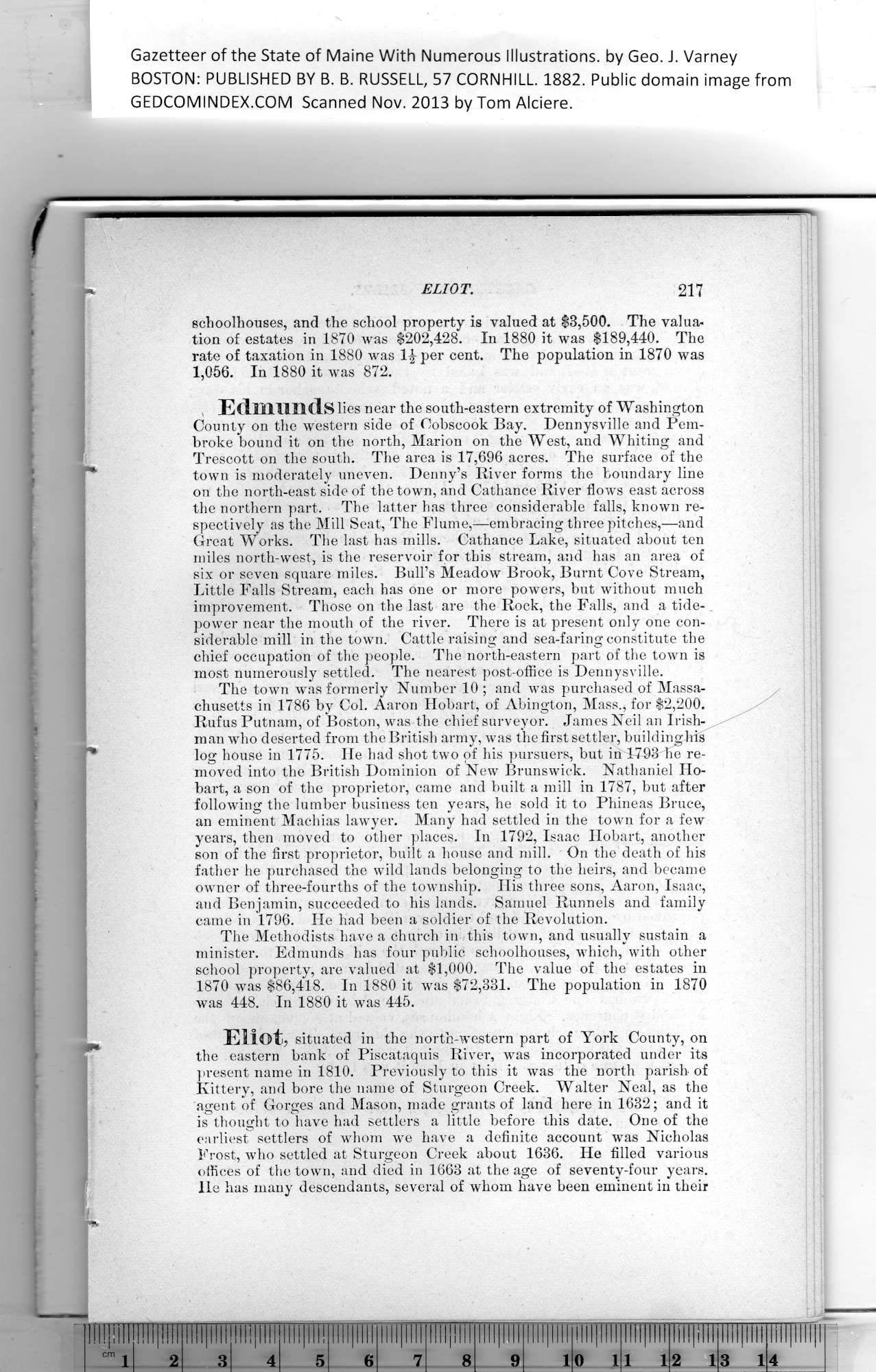|
Gazetteer of the State of Maine With Numerous Illustrations, by Geo. J. Varney
BOSTON: PUBLISHED BY B. B. RUSSELL, 57 CORNHILL. 1882. Public domain image from
ELIOT. 217
schoolhouses, and the school property is valued at $3,500. The valua-
tion of estates in 1870 was $202,428. In 1880 it was $189,440. The
rate of taxation in 1880 was l|-per cent. The population in 1870 was
1,056. In 1880 it was 872.
, Edmunds ies near the south-eastern extremity of Washington
County on the western side of Cobscook Bay. Dennysville and Pem-
broke bound it on the north, Marion on the West, and Whiting and
I Trescott on the south. The area is 17,696 acres. The surface of the
**■ town is moderately uneven. Denny’s River forms the boundary line
on the north-east side of the town, and Cathance River flows east across
the northern part. The latter has three considerable falls, known re-
spectively as the Mill Seat, The Flume,—embracing three pitches,—and
Great Works. The last has mills. Cathance Lake, situated about ten
miles north-west, is the reservoir for this stream, and has an area of
six or seven square miles. Bull’s Meadow Brook, Burnt Cove Stream,
Little Falls Stream, each has one or more powers, but without much
improvement. Those on the last are the Rock, the Falls, and a tide-
power near the mouth of the river. There is at present only one con-
siderable mill in the town. Cattle raising and sea-faring constitute the
chief occupation of the people. The north-eastern part of the town is
most numerously settled. The nearest post-office is Dennysville.
The town w\as formerly Number 10 ; and was purchased of Massa-
chusetts in 1786 by Col. Aaron Hobart, of Abington, Mass., for $2,200.
Rufus Putnam, of Boston, was the chief surveyor. James Neil an Irish-
man who deserted from the British army, was the first settler, buildinghis
log house in 1775. He had shot two of his pursuers, but in 17-93"he re-
moved into the British Dominion of New Brunswick. Nathaniel Ho-
bart, a son of the proprietor, came and built a mill in 1787, but after
following the lumber business ten years, he sold it to Phineas Bruce,
an eminent Machias lawyer. Many had settled in the town for a few
years, then moved to other places. In 1792, Isaac Hobart, another
son of the first proprietor, built a house and mill. On the death of his
father he purchased the wild lands belonging to the heirs, and became
owner of three-fourths of the township. His three sons, Aaron, Isaac,
and Benjamin, succeeded to his lands. Samuel Runnels and family
came in 1796. He had been a soldier of the Revolution.
The Methodists have a church in this town, and usually sustain a
minister. Edmunds has four public schoolhouses, which, with other
school property, are valued at $1,000. The value of the estates in
1870 was $86,418. In 1880 it was $72,331. The population in 1870
was 448. In 1880 it was 445.
Eliot, situated in the north-western part of York County, on
the eastern bank of Piscataquis River, was incorporated under its
present name in 1810. Previously to this it was the north parish of
Kittery, and bore the name of Sturgeon Creek. Walter Neal, as the
agent of Gorges and Mason, made grants of land here in 1632; and it
is thought to have had settlers a little before this date. One of the
earliest settlers of whom we have a definite account was Nicholas
Frost, who settled at Sturgeon Creek about 1636. He filled various
offices of the town, and died in 1663 at the age of seventy-four years,
lie has many descendants, several of whom have been eminent in their
PREVIOUS PAGE ... NEXT PAGE
This page was written in HTML using a program written in Python 3.2
|
